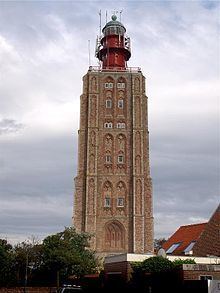Population 2,705 (1 Feb 2010) | Time zone CET (UTC+1) Local time Saturday 1:16 PM | |
 | ||
Weather 13°C, Wind W at 13 km/h, 74% Humidity Points of interest Polderhuis Westkapelle, Hoge Vuurtoren van West, Noorderhoofd | ||
Westkapelle is a small city in the municipality of Veere on the island Walcheren, in the province Zeeland of the Netherlands. On 1 January 2005, it had a population of 2,671. Westkapelle is on the westernmost tip of Walcheren and is surrounded by the sea on three sides.
Contents
- Map of Westkapelle Netherlands
- Second World War
- Two lighthouses
- Nicknames
- Remarkable events
- Panoramic view
- References
Map of Westkapelle, Netherlands
Westkapelle was a separate municipality from 1816 until 1997, when it was merged with Veere.
Second World War
On 3 October 1944, the dyke to the south of town was destroyed by British bombers – an event still known in Westkapelle simply as "'t Bombardement" ("the Bombardment") – to flood the German occupation troops in Walcheren and so make liberation easier. 180 inhabitants were killed in the bombing and the village was all but wiped off the face of the earth by the bombs and the incoming sea. On 1 November 1944, Allied troops performed an amphibious landing on the northern and southern edges of the gap made in the dyke. During these landings, only six people remained in the village; the rest of the survivors had been evacuated to other villages nearby. It took until 12 October 1945, more than a year later, to finally close the gap in the dyke.
A visible reminder of the Second World War is the brackish lake formed by the inrushing flood when the dike was bombed. An M4 Sherman tank was placed on the dyke as a memorial to the war and to the village's liberation. Behind the lighthouse, placed in a semicircle, are the graves of the war dead.
Two lighthouses
Westkapelle has two active lighthouses.
The oldest lighthouse, built 1458-1470, 52 m (171 ft) tall, visible from 28 nautical miles (52 km; 32 mi) and standing prominently at the entrance to the village, is the remainder of a church that burned down in the 18th century. In 1818 the light was added to the top.
The other one, standing on the outer slope of the dyke, was built in 1875 of cast iron, is only 16 m (52 ft) tall and has a visibility range of 13 nautical miles (24 km; 15 mi).
Together they form leading lights, that lead vessels coming from the northern part of the North Sea into the narrow and busy shipping lane directly under the south west coast of Walcheren, that brings them into the Scheldt estuary and towards the ports of Flushing, Terneuzen, Ghent (via the Ghent–Terneuzen Canal) and Antwerp.
Confusingly there is a third - inactive - lighthouse on the inner side of the dyke. It is part of the Dijk- en Oorlogsmuseum (Dyke and War museum), and never has been active at that place.
Nicknames
For a long time, Westkapelle was a very closed community, although this is less so nowadays due to tourism and the so-called import (people who moved to the village from other parts of the Netherlands). This was, and is, obvious from the limited number of surnames in the village; furthermore, because it was customary to name children after their grandparents, (great)uncles and (great)aunts, many people had exactly the same name.
To avoid confusion, nicknames were — and are — used in daily life. These vary enormously, and are sometimes attached to a single person but sometimes also to a family, and often a combination of both. The nickname can be derived from someone's real name, refer to one of his or her parents (and sometimes multiple generations back), and/or come from something completely different — again, combinations of these factors are commonplace. Outsiders who are not aware of this custom can experience difficulties because of it, since someone's real name is sometimes only barely known: he or she is really only known by the nickname, and remembering the real name is a bit of an effort.
For more official business, the father's first initial was often appended following the surname, followed by the letter "z" or "d" (for the Dutch "zoon" or "dochter", son or daughter): the name Johanna Minderhoud Hd, for example, indicates that she is the daughter of H. Minderhoud ("Hd" is short for "H-sdochter"): see patronymic. This was even used in such things as obituaries.
Remarkable events
In 2012 Westkapelle was startled by a case of sexual abuse of unprecedented scale. Resident Joost W. confessed that he had abused more than 100 boys from the age of 12 to 18 years. This happened from the late 1960s until 2011. Many cases on which the public prosecutor had statements were barred. The Prosecutor estimated that the man had contact with 250 underage boys in forty years time. The sexual acts with the boys were performed in exchange for cash, a crate of beer, credit, cigarettes or snacks in the cafeteria.
In September 2012 the 60-year-old Joost W was sentenced to 2 years in prison and preventive detention by the District Court in Middelburg
This case is not only remarkable because of the large number of victims. Within the community of Westkapelle the sexual abuse by Joost W. was an open secret. Parents warned their own children, but did nothing else. Therefore, the offender could go undisturbed for 40 years with the abuse of young boys. When the case came out in February 2012, the village responded with resignation.
Panoramic view
Westkapelle is surrounded at three sides by sea. Standing on the dyke at the westernmost tip, the 360° panoramic view over the village, the sea and the shipping lane - surprisingly close to the coast - is spectacular.
